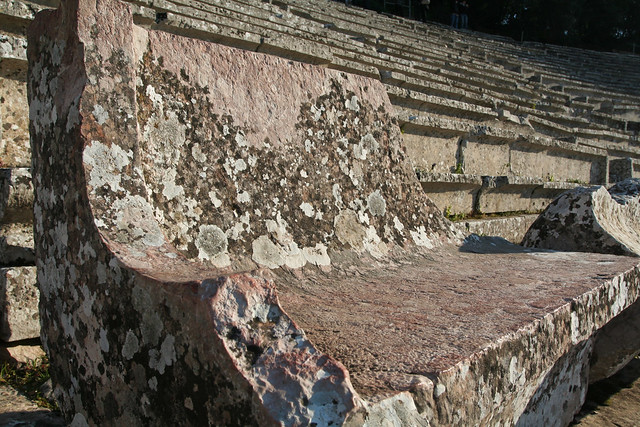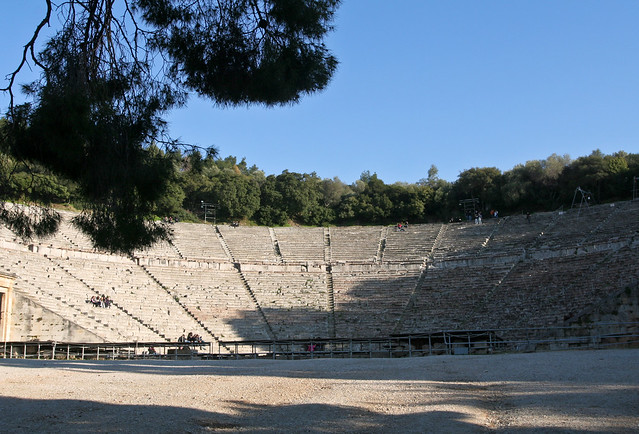
Polykleitos the Younger designed the 4th century theater of Epidaurus near the town of Epidavros in Greece on the Saronic Gulf. It was built on Argolis, the reputed birthplace of Apollo’s son Asclepius, the god of healing.
Healing – The Greek theater was typically dedicated to Apollo, the god of music who integrated art and healing. Patients came from afar and hiked up the mountain to this location. They received drama and entertainment as part of a healing process, rituals that helped avoid future evil as well as heal current illness and injury. The theater drama was just one step in the healing experience. It dates back to even more ancient cults which used magic songs to cure diseases and drama performances to explain religious mythology.
Polykleitos originally built 34 rows that seated 6,200 people, in front of a magnificent vista view. This was later increased to 55 rows for 12,000 people. They hung black cloths to portray night, wheeled in large sets, and suspended actors in the air to make more fantastic and versatile performances than had ever been seen on stage.
Perfect Geometry – Ancient designers used precise design for acoustics, necessary for an outdoor theater. The overall design and each detail shows advanced knowledge of sound properties truly was ahead of its time. Vitrivius describes a floor plan derived from the zodiac and musical scale. The Epidaurus theater is different from all other theaters, however, as it is based on the 5-star pentagon rather than the 6-star hexagon. This may be because the theater was hastily built from the ruins of a Trajan-era gymnasium, when pentagon-shaped buildings were being built.
Greater emphasis was placed on harmonic geometry, with a 9.8m circular orchestra of limestone that was not typical of ancient theaters. A religious altar stood in the center, and double choruses surrounded the altar speaking the will of the gods to the people. Physicians and priests took part in the “holy theater.” Performances were categorized into tragedy, comedy, and satire.
Entertainment – Epidaurus is a large theater, but not the largest theater of that time, and that is actually why it survives. It was cheaply built, materials scrambled together from the peristyle court of old earthquake-ruins, and was not a very important building to the locals. Epidarans had their own theater in the city. This theater on the mountain was for pilgrims, and really turned into a commercial enterprise. It was out of the way and drab, which is likely why nobody bothered to destroy it. Thus, Epidaurus is the best preserved of all Hellenistic theaters.
This shift from detailed, sacred structure to minimalistic, cheap building was part of Rome’s overall shift toward entertainment. The coliseum in Rome likewise was colossal, minimal, and turned sacred rituals into spectator sport. This is also why Epidaurus is relevant to us today, as theater drama and musical art is secular and entertainment-based. This triumph of early theatre still stands as a model for today’s performance halls.
More Info , More Info , More info , Ancient Greek theatre


(Sharon Mollerus– flickr/creative commons license)

(Sharon Mollerus– flickr/creative commons license)

(Sharon Mollerus– flickr/creative commons license)

(Sharon Mollerus– flickr/creative commons license)

(HBarrison– flickr/creative commons license)
